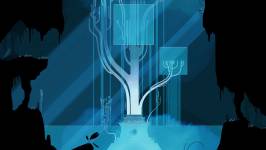Playing as Gris, players need to explore her world by solving all kinds of interesting puzzles and discovering new abilities so as to ‘restore colors’ to her world, as well as helping her get over her profound sadness and fear. Yet what makes GRIS stand out from most games of the same genre is not the story of an unfortunate character dealing with difficulties, but it is its unique storytelling— through the use of visualization and atmosphere.
In the beginning of the game, Gris is singing on the palm of a gigantic female statue before she abruptly loses her voice and falls a long way down into the middle of nowhere. There, Gris slowly stands and finds out that she is surrounded by a vast desert filled with collapsed buildings and mysterious creatures. Everything seems to be lifeless and bereft of color.
Judging from the surrounding, players can assume that the young girl is in the stage of denial. She denies the true color of the sand she walks on; she denies the true color of any architecture she comes across; she denies the true color of any creatures she has met; and most importantly, she denies the fact about her loss. All Gris can do now is just drag her body across this inhospitable landscape.
When more parts of the colossal female statues are found, the livelier the world becomes. Having taken a long walk, Gris has finally found the remaining hand of the female woman statue. A blotch of watercolor spreads across the screen, soaking Gris’ entire world with redness, which signifies that she has already made her way to the second stage of grief: anger.

Here, Gris encounters powerful winds that cannot only turn the whole screen a dark crimson, but it can also set her far back. The only warning players get of this sudden change is when the peaceful piano music begins to change, growing more menacing.
Initially, to avoid the effect of these gales, players need to stay in a shelter until the gales recedes. However, after learning a new ability that allows her to turn herself into a block at any time, Gris is able to withstand them.
It is possible that the winds could be interpreted as an intense emotion Gris has; yet the amount of anger (whether derived from blaming herself or whatever factor related to the loss) is so much that she has no clue on how to directly deal with it at first. Thus, the only options she has are either a) trying to get to a place where she feels safe or b) go with the flow of anger. Gris realizes that instead of preventing this burst of negative emotion from happening, she should embrace it and discover a proper way to deal with such an emotion by herself— it seems that the young girl is growing up.
As the concept of growth is an essence of the game, players will witness how Gris gradually regains herself and becomes emotionally mature each stage. For instance, in a forest where the young girl encounters a block-headed creature, that is placing its hands on its belly, Gris’ multiple attempts to befriend it are in vain as it always hides itself in the ground when she gets close.
By the time she has transformed herself into a block and accidentally drops herself on a treetop, an apple falls onto the ground and the block-headed creature rushes out to eats it and hides itself again. Realizing that her fellow creature is hungry and that she should give it something before she can get anything in return, Gris needs to figure out a way to solve several tricky puzzles in order to repeat the act and feed the creature as much as possible. Right after she satisfies its hunger, the first friendship finally takes place on her lonely journey and a cheerful smile returns on her face once again.
Speaking of regaining oneself, not only applies to Gris but also to those who are in the same situation as she is. Having recently suffered from a considerable distress, people are occasionally overwhelmed with unbearable feelings to the extent that they almost forget how to reconnect to themselves and others. Because GRIS uses mild watercolor graphics, watching or playing the game can soothe one’s soul from the overwhelming emotions and gently remind them what important things in life they still have, or how they used to be so that they could feel encouraged to move on.


Another interesting aspect about the game that I almost forgot to mention is that not a single word exists in GRIS. I find this aspect suited perfectly fit to the game as it makes the game even more gorgeous since words are rarely able to capture our complex and delicate emotions. Besides, I personally think conveying one’s feelings through images could reveal their subconscious mind such as hidden desires or personality, and that makes the gaming experience more personal and wonderful. Also, this will further benefit players as it leaves room for the interpreting of symbols and other meaningful elements that the game presents to them so that they are able to embroider a story that touches their heart most.
Apart from art and visuals, GRIS also does a great job in terms of its audio. Performed by Berlinist— a music band based in Barcelona, the music in each scene is unique, while also sharing the same soft and sorrowful yet hopeful quality. For this reason, I can spend an entire 10 minutes just to listen to the music alone before grabbing a controller to move the character forwards.
However, GRIS has some serious problems compared to other general games. First of all, the game is so short that it can be completed it in just three hours. Secondly, it also has very low replay value. Nevertheless, these problems commonly occur in most indie games that aim to sell their outstanding content and is therefore not a serious flaw as long as they can provide players with a pleasant and unforgettable experience.









เข้าสู่ระบบเพื่อแสดงความคิดเห็น
Log in